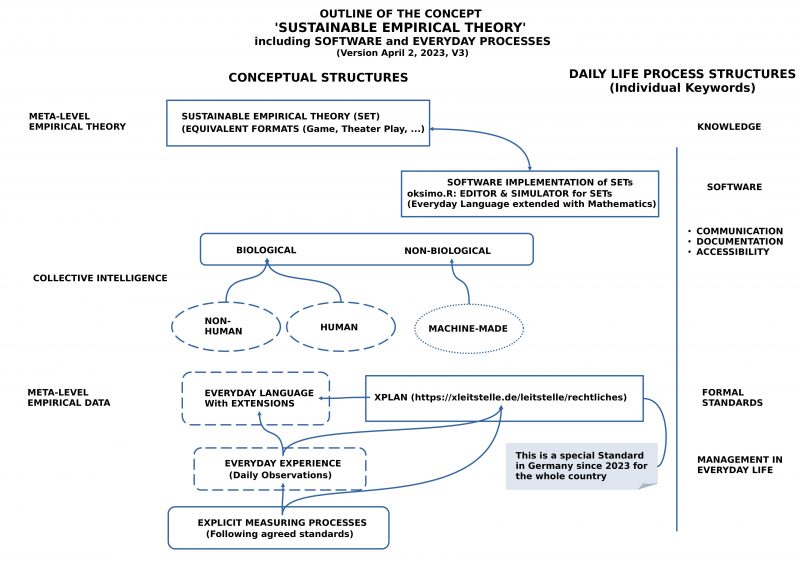eJournal: uffmm.org
ISSN 2567-6458, 23.March 2023 – April 4, 2023
Email: info@uffmm.org
Author: Gerd Doeben-Henisch
Email: gerd@doeben-henisch.de
CONTEXT
This text starts the topic of the Collective Man-Machine Intelligence Paradigm within Sustainable Development.
OUTLINE
For most readers the divers content of this blog is hard to understand if told that all these parts belong to one coherent picture. But indeed, there exists one coherent picture. This is the first publication of this one coherent picture.

Looking deeper into this figure you can perhaps get a rough idea, which kinds of questions had to be answered before this unified view could be formulated. And every subset of this view is backed up by complete formal specifications and even formal theories. Telling the story ‘afterwards’ is often ‘simple’, but to find all the different parts in the ‘overall picture’ one after the other is rather tedious. At last I needed about 50 years of research …
In the next weeks I will write some more comments. As always there are many ‘threads’ working in parallel and I have to complete some others before.
The Everyday Application Scenario
(The following text is an English translation from an originally German text partially generated with the www.DeepL.com/Translator (free version))
Having a meta-theoretical concept of a ‘sustainable empirical theory (SET)’ accompanied by the meta-theoretical concept of ‘collective intelligence (CI)’ it isn’t straightforward how these components are working together in an everyday scenario. The following figure gives a rough outline of that framework which — probably — has to be assumed.

CONCEPTS AND PROCESSES
To have abstract (meta-theoretical) concepts it isn’t sufficient to change the real world only with these. It needs always some ‘translation’ of abstract meanings into concrete, real processes which are ‘working in everyday real environments’. Thus, every ‘concept’ needs a bundle of ‘processes’ associated with the meaning of the abstract concept which are capable to bring the abstract meaning ‘into life’.
Theory Concept
A structural concept describes e.g. on a meta-level what a ‘sustainable empirical theory’ is and compares this concept with the concept ‘game’ and ‘theater play’. Since it can quickly become very time-consuming to write down complete theories by hand, it can be very helpful to have a software (there is one under the name ‘oksimo.R’) that supports citizens in writing down the ‘text of a theory’ together with other citizens in ‘normal language’ and also to ‘simulate’ it as needed; furthermore, it would be good to be able to ‘play’ a theory interactively (and ultimately even much more).
Having the text of a theory, trying it out and developing it further is one thing. But the way to a theory can be tedious and long. It requires a great deal of ‘experience’, ‘knowledge’ and multiple forms of what is usually very vaguely called ‘intelligence’.
Concept Collective Intelligence
Intelligence typically occurs in the context of ‘biological systems’, in ‘humans’ and ‘non-humans’. More recently, there are also examples of vague intelligence being realized by ‘machines’. In the end, all these different phenomena, which are roughly summarized under the term ‘intelligence’, form a pattern which could be considered as ‘collective intelligence’ under a certain consideration. There are many prominent examples of this in the field of ‘non-human biological systems’, and then especially in ‘human biological systems’ with their ‘coordinated behavior’ in connection with their ‘symbolic languages’.
The great challenge of the future is to bring together these different ‘types of individual and collective intelligence’ into a real constructive-collective intelligence.
Concept Empirical Data
The most general form of a language is the so-called ‘normal language’ or ‘everyday language’. It contains in one concept everything we know today about languages.
An interesting aspect is the fact that the everyday language forms for each special kind of language (logic, mathematics, …) that ‘meta-language’, on whose basis the other special language is ‘introduced’.
The possible ‘elements of meaning and structures of meaning’, out of which the everyday language structures have been formed, originate from the space of everyday life and its world of events.
While the normal perceptual processes in coordination among the different speaker-listeners can already provide a lot of valuable descriptions of everyday properties and processes, specialized observation processes in the form of ‘standardized measurement processes’ can considerably increase the accuracy of descriptions. The central moment is that all participating speaker-listeners interested in a ‘certain topic’ (physics, chemistry, spatial relations, game moves, …) agree on ‘agreed description procedures’ for all ‘important properties’, which everyone performs in the same way in a transparent and reproducible way.
Processes in Everyday Life
As pointed out above whatever conceptual structures may have been agreed upon, they can only ‘come into effect’ (‘come to life’) if there are enough people who are willing to live all those ‘processes’ concretely within the framework of everyday life. This requires space, time, the necessary resources and a sufficiently strong and persistent ‘motivation’ to live these processes every day anew.
Thus, in addition to humans, animals and plants and their needs, there is now a huge amount of artificial structures (houses, roads, machines,…), each of which also makes certain demands on its environment. Knowing these requirements and ‘coordinating/managing’ them in such a way that they enable positive ‘synergies’ is a huge challenge, which – according to the impression in 2023 – often overtaxes mankind.
